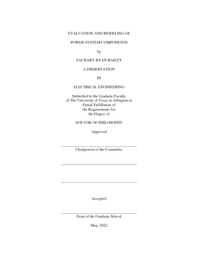
ATTENTION: The works hosted here are being migrated to a new repository that will consolidate resources, improve discoverability, and better show UTA's research impact on the global community. We will update authors as the migration progresses. Please see MavMatrix for more information.
Show simple item record
| dc.contributor.advisor | Wetz, David A | |
| dc.creator | Bailey, Zachary Ryan | |
| dc.date.accessioned | 2022-06-28T15:12:16Z | |
| dc.date.available | 2022-06-28T15:12:16Z | |
| dc.date.created | 2022-05 | |
| dc.date.issued | 2022-06-01 | |
| dc.date.submitted | May 2022 | |
| dc.identifier.uri | http://hdl.handle.net/10106/30405 | |
| dc.description.abstract | Future power system architectures will rely on a combination of rotating machines, power electronic devices, and energy storage. While it is possible to procure each component separately and conduct studies incorporating these devices into a system, increases in computing power and advanced computer modeling software have expanded the opportunity for research to be conducted on power system architectures without the need for actual hardware. This provides flexibility by allowing the user to design models of individual components that can then be integrated together or effortlessly interchanged depending on the function or testbed design that is being studied.
The UTA IDEAL testbed consists of multiple components that are representative of hardware found in many power system applications and this effort develops a process for modeling and characterization of three pieces of equipment. Though it is less power dense than many other chemistries, lithium-titanate-oxide (LTO) chemistry is one that is able to be symmetrically charged and discharged making it attractive in many applications. For this reason, two LTO cells were studied by first characterizing their properties and then capturing that characterization in a mathematical model that could potentially be used with current hardware in the testbed to simulate the presence of this battery without the requirement to purchase a large number of individual cells and supporting equipment. This is an important component within future power systems since energy storage devices can buffer renewable and non-stiff electrical power generation sources. This buffering capability was later shown during the modeling effort of the two motor-generator (M-G) sets within the testbed. Next, a method was developed for modeling a three-phase generator as well as a nine-phase generator connected to a bus containing a 1 kV lithium-ion battery. During testing of the multi-phase generator, the buffering ability of the energy storage device was also demonstrated. Models were developed in MATLAB/Simulink and the results from these models were compared to the results obtained from actual hardware to show that the models accurately predict the hardware’s behavior for specific cases with predefined output variable requirements. | |
| dc.format.mimetype | application/pdf | |
| dc.language.iso | en_US | |
| dc.subject | Lithium-ion | |
| dc.subject | Motor-generator | |
| dc.subject | Modeling | |
| dc.subject | MATLAB/Simulink | |
| dc.title | Evaluation and Modeling of Power System Components | |
| dc.type | Thesis | |
| dc.degree.department | Electrical Engineering | |
| dc.degree.name | Doctor of Philosophy in Electrical Engineering | |
| dc.date.updated | 2022-06-28T15:12:16Z | |
| thesis.degree.department | Electrical Engineering | |
| thesis.degree.grantor | The University of Texas at Arlington | |
| thesis.degree.level | Doctoral | |
| thesis.degree.name | Doctor of Philosophy in Electrical Engineering | |
| dc.type.material | text | |
Files in this item
- Name:
- BAILEY-DISSERTATION-2022.pdf
- Size:
- 6.563Mb
- Format:
- PDF
This item appears in the following Collection(s)
Show simple item record


